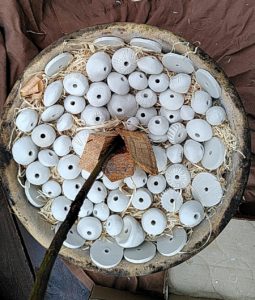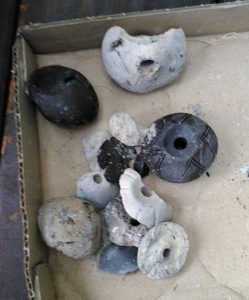Search the Blog
Latest Comments
Miriam Griffiths
A Little Help...
27 November 2024
Perhaps more "was once kinda good and then someone added AI"? I'm getting very fed up of the amount ...
Natalie
A Mysterious Hole...
26 November 2024
Oh my! I cannot tell what the hole's size is, but I expect someone is hungry and may be going for ea...
Katrin
Very Old Spindle Whorls?
25 November 2024
Yes, the weight is another thing - though there are some very, very lightweight spindles that were a...
Katrin
A Little Help...
25 November 2024
Ah well. I guess that is another case of "sounds too good to be true" then...
Miriam Griffiths
Very Old Spindle Whorls?
22 November 2024
Agree with you that it comes under the category of "quite hypothetical". If the finds were from a cu...
Fire in the Bowl.
My hair still smells a bit like wood fire... a nice smell, if you ask me. It reminds me of many, many different activities, and lovely times with friends and colleagues, in many different settings.
Yesterday's fire was a true work-fire, though - and since I had a lot of other things to do as well, I didn't get to sit down, relax, and enjoy watching the flames this time around. I didn't even make coffee on top of the spindle whorls, that would have been fun, and it's definitely on my list for the next time!
Firing whorls, the way I do it, is a kind of simulated pit firing. Instead of digging a hole in the garden and filling it with wood and the things to fire, I use a clay fire bowl (which is also the bowl that travels to Living History events with me). The bowl keeps the warmth of the fire nicely as opposed to the metal fire bowls, thus making cooking much more efficient in terms of fuel use. And for firing whorls, it is quite good at simulating the dugout pit.
In pit firing, generally, there's a high percentage of reduction firing (most of the whorls will turn out at least partly black). Temperature control is possible only in a limited way, by choosing how you build up your fire/pit, and what kinds of wood you use, and how long you let the fire burn. In my case, the firing temperature is not very high to quite low, and there is also always some loss of whorls if they get heated too quickly, or too unevenly.
But you want pictures, right? Here you go.
It all starts with filling the bowl with wood, wood shavings and, of course, whorls. It's a bit like whorl lasagna.

I start the fire on top of the whole thing then, trying to heat it up as slowly as possible. When that does not work out as well as intended, I get to hear cracking sounds... which means exploding whorls.

That is not a good sound - but there is some loss, that's just how it is.
Firing then goes on, with me putting more bits of wood on, and trying to have it burn nice and hot all the time:

That takes a few hours. It would definitely be enough time to make coffee on top of the whorls!

Once the firing is done, the bowl has to cool off a bit before I can take out the whorls. Usually I have a hard time waiting long enough, but I don't want to risk more damaged whorls because of taking them out too quickly. Then, once they're completely cold, the ashes and soot have to be wiped off or washed off, and once the whorls are completely dried again, I can weigh and sort them.
Here's the dead ones from yesterday's pit:

About ten whorls that did not make it, approximately. Not too bad - though I've done better in the past!
Yesterday's fire was a true work-fire, though - and since I had a lot of other things to do as well, I didn't get to sit down, relax, and enjoy watching the flames this time around. I didn't even make coffee on top of the spindle whorls, that would have been fun, and it's definitely on my list for the next time!
Firing whorls, the way I do it, is a kind of simulated pit firing. Instead of digging a hole in the garden and filling it with wood and the things to fire, I use a clay fire bowl (which is also the bowl that travels to Living History events with me). The bowl keeps the warmth of the fire nicely as opposed to the metal fire bowls, thus making cooking much more efficient in terms of fuel use. And for firing whorls, it is quite good at simulating the dugout pit.
In pit firing, generally, there's a high percentage of reduction firing (most of the whorls will turn out at least partly black). Temperature control is possible only in a limited way, by choosing how you build up your fire/pit, and what kinds of wood you use, and how long you let the fire burn. In my case, the firing temperature is not very high to quite low, and there is also always some loss of whorls if they get heated too quickly, or too unevenly.
But you want pictures, right? Here you go.
It all starts with filling the bowl with wood, wood shavings and, of course, whorls. It's a bit like whorl lasagna.

I start the fire on top of the whole thing then, trying to heat it up as slowly as possible. When that does not work out as well as intended, I get to hear cracking sounds... which means exploding whorls.

That is not a good sound - but there is some loss, that's just how it is.
Firing then goes on, with me putting more bits of wood on, and trying to have it burn nice and hot all the time:

That takes a few hours. It would definitely be enough time to make coffee on top of the whorls!

Once the firing is done, the bowl has to cool off a bit before I can take out the whorls. Usually I have a hard time waiting long enough, but I don't want to risk more damaged whorls because of taking them out too quickly. Then, once they're completely cold, the ashes and soot have to be wiped off or washed off, and once the whorls are completely dried again, I can weigh and sort them.
Here's the dead ones from yesterday's pit:

About ten whorls that did not make it, approximately. Not too bad - though I've done better in the past!
Comments
No comments made yet. Be the first to submit a comment



